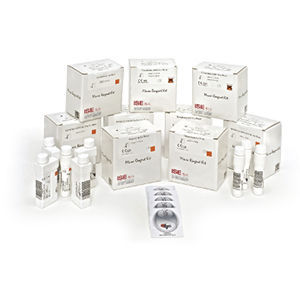
Solution reagent kit A-R0100000601 blood samplefor clinical chemistryliquid
Add to favorites
Compare this product
Characteristics
- Type
- solution
- Applications
- blood sample, for clinical chemistry
- Format
- liquid
- Tested parameter
- glucose
Description
Product for use in the quantitative determination in vitro of the concentration of the
Glucose in human serum or plasma. The results of the test must always be interpreted
in conjunction with the clinical context. For professional use only.
CLINICAL SIGNIFICANCE
Glucose is the result of the chemical decomposition of carbohydrates introduced in the
diet and is the primary source of energy for the human organism. When the energetic
intake is greater than the energy used, the glucose in excess is converted into fat and
glycogen which will be deposited in the form of energy reserves, in the adipose tissue,
in the liver and muscles. The glucose concentration in human blood is regulated, within
a narrow range, by the action of regulatory hormones such as insulin, glucagon or
epinephrine. The most widespread disorder of carbohydrate metabolism is diabetes
mellitus, which is evidenced by high blood glucose levels.
PRINCIPLE
In accordance with Trinder’s reaction, glucose oxidase (GOD) oxidates glucose to
gluconic acid with the formation of hydrogen peroxide, which in the presence of
peroxidase (POD), 4-aminophenazone and phenol gives rise to a coloured compound,
the intensity of which is directly proportional to the glucose concentration in the sample.
Catalogs
No catalogs are available for this product.
See all of ISE‘s catalogsRelated Searches
- Solution reagent kit
- Protein reagent kit
- Laboratory reagent kit
- Antibody
- Clinical chemistry reagent
- Clinical chemistry analyzer
- Blood sample reagent kit
- Automatic clinical chemistry analyzer
- Benchtop clinical chemistry analyzer
- Electrolyte reagent kit
- Blood clinical chemistry analyzer
- Enzyme reagent
- Clinical chemistry analyzer with ISE
- Serum clinical chemistry analyzer
- Random access biochemistry analyzer
- Plasma clinical chemistry analyzer
- Biochemistry analyzer with touchscreen
- Compact clinical chemistry analyzer
- Reagent for antigens
- Glucose reagent kit
*Prices are pre-tax. They exclude delivery charges and customs duties and do not include additional charges for installation or activation options. Prices are indicative only and may vary by country, with changes to the cost of raw materials and exchange rates.







